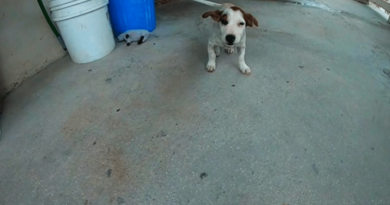Can We Still Save Their Eyes? – Top Dog Tips
Are you looking for a viable blind dog treatment?
It’s said that vision loss makes your dog miss a lot of things in life. That’s why we, as their owners, are persistent in finding solutions to treat our dog’s blindness.
We don’t want our dogs to experience a limited “view” of life only through their sense of smell and hearing.
In this article, we’ll discuss the causes of blindness and how to treat blindness in dogs. We’ll also be talking about how you and your dog can adapt to its new handicap condition.
Dog Blindness: What Causes it?
There is a myriad of reasons why dogs become blind. Ultimately, you can group these reasons into four notable categories.
The primary reasons why dogs go blind are:
- Disease
- Heredity
- Old age
- Unfortunate accidents
It’s also worth noting that there are instances of blindness amongst dogs that have no exact reason at all.
Sudden Acquired Retinal Degeneration Syndrome (SARDS) is an illness that almost spontaneously blinds the dog in a matter of days.
There’s no definitive cause for this disease, making any treatment for blind dogs impossible.
Age
When dogs become old, they experience degeneration of muscles, tissues, and organs. One body part of a dog that’s susceptible to persistent degeneration is its eyes.
You may notice that there’s a large percentage of senior dogs that are blind. Well, this is no coincidence, as age is a major factor in causing blindness in dogs.
As dogs grow older, a lot of the tissues in the eyes will die or get damaged. The eyes also stopped reproducing and regenerating new cells and tissues.
Additionally, old age also invites diseases that negatively affect your dog’s vision. With no tissues to replace the deteriorating ones, any lost vision is not recoverable.
When age becomes your enemy, treatment for blind dogs might not be possible.
Heredity
Another big player in causing vision loss in dogs is their genes.
Some dogs and dog breeds have dominant genes in them that trigger certain eye-related ailments as they grow up.
Hereditary types of blindness are also becoming specific to some breeds.
This means that some breeds are becoming more and more prone than other breeds to contract this type of disease.
In most cases, genetic-related vision loss happens as they grow old. But there are instances that these diseases strike at any given age of the dog.
Among the list of inherited visual impairments, the most notorious inherited disease is Progressive Retinal Apathy (PRA).
PRA is the deterioration of your dog’s vision that starts with the degeneration of photoreceptors in its eyes.
Dogs that are starting to suffer from PRA become night-blind first. From then, it’s a domino effect of other eye components deteriorating.
Other inherited vision loss ailments are:
Unfortunate Accidents
When people think about blindness-causing accidents, they mostly think of sharp objects piercing your dog’s eyes.
But that’s only one way of inducing blindness during accidents.
In general, accidents cause blindness because they deal irrecoverable damage to the eye in a short time.
By this definition, it can also mean a blunt force that forces the dog’s eyes to contract and expand.
It can also be fires, explosives, and radiation that singe and burn the eyes.
There are also chemicals compound that, when a dog ingests them, will kill the optic nerves.
Other unfortunate accidents that will take away your dog’s vision are:
- Car Accidents
- Defective Dog Products
- Dangerous Dog Toys
- Wildlife Encounters
Diseases
Getting diagnosed with a disease can also sometimes lead to visual impairment. Blindness in dogs can appear as a direct symptom or a disease complication.
Here are some of the most common diseases that can cause blindness as a symptom or complication.
A cataract is an optical disease that vets characterize as a cloudy or opaque eye lens in dogs. The cloudy lump of proteins hinders the eyes from producing a clear visual.
Glaucoma is another optical disease because of the increase in intraocular or fluid pressure inside the eyes.
Diabetic dogs have high sugar levels in their bodies that may damage the blood vessels in their retinas. This is a diabetic complication called diabetic retinopathy.
Types of Blindness in Dogs
People often use the word blindness for complete vision loss. But in reality, not all blindness in dogs is the same.
Blindness is a spectrum, ranging from limited vision to none at all.
As such, here are the three major types of blindness in dogs.
Full Blindness
Full blindness is when the dog’s eyes completely can’t see anymore. We also call this total blindness to emphasize that the eyes have lost the ability to perceive light.
This type of blindness is what we usually associate with the word “blindness.”
Partial Blindness
Unlike total blindness, partial blindness refers to vision loss that can still see up to a certain aspect.
This means that the dog hasn’t fully lost its ability to perceive light and vision yet.
Instead of completely losing vision, your dog will have irreversible vision impairment. These types of vision impairment differ in how they limit your dog’s vision.
For example, partial-blindness cataracts hamper vision because of cloudy lenses that result in foggy vision.
Diabetic retinopathy, on the other hand, will result in dark spots and shadows in your dog’s vision.
Sometimes, this impairment may progress into a more severe case that can ultimately lead to full blindness.
Intermittent Blindness
Intermittent Blindness is when the dog experiences temporary blindness on random occasions.
This means that the dog can suffer from episodic blindness at one time and regain its vision shortly after.
Temporary blindness has different causes. A lot of these causes are different from what can induce full blindness in dogs.
Some of the causes of intermittent blindness are:
Symptoms of Dog Blindness
A dog will slowly lose its vision as they age unless an ocular disease afflicts it.
This gradual process of losing vision makes it difficult for owners to detect whether their dog has gone blind or not.
But for the most part, an eye disease will give off striking symptoms that you can identify as blindness.
Take note of these symptoms well, as they tell you about your dog’s eye condition. It can also indicate what type of ailment your dog currently has.
RELATED: HOW TO TELL IF A DOG IS BLIND
Physical Symptoms
Physical symptoms are the obvious warning signs of dog blindness. It immediately tells you that something is wrong with your dog’s eyes, whether it’s blindness or not.
Some of the physical symptoms of blindness that you need to watch out for are:
- Enlarged pupils
- Bloodshot red eyes
- Cloudiness in one or both eyes
- Visible veins in the eyes
- Swollen eyes
- Lazy eyes
- White or dark spots in the eyes
- Fixed pupils even at changing light levels
Behavioral Symptoms
Sometimes vision loss will not show any physical symptoms in dogs. You can, however, check their behaviors instead for subtle signs of their blindness.
After all, blindness will ultimately affect and bring change to your dog’s lifestyle. Here are some behavioral signs that may tell about your dog’s vision impairment.
- Bumping and crashing into objects
- Not making eye contact
- Anxiety
- Confusion
- Clumsiness
- Reluctancy to go outside
- Hesitation
- Depression
- Susceptible to chase sound and smell stimulations
- Excessive signs of fatigue
- Unable to catch tossed treats
How to Treat Dog Blindness
Now, for the million-dollar question: do we have a proper dog blindness treatment? Do we have a curing treatment for blind dogs?
Unfortunately, there’s no direct yes-and-no answer to these questions yet.
Blindness, in general, is still by far an incurable, sometimes even untreatable, illness.
Countless dogs may suffer vision loss throughout their lifespan. This is true with human blindness as well.
On one end of the blind spectrum, some blindness-inducing diseases and ailments are still untreatable.
It’s estimated that there are now 100 dog breeds that have the hereditary PRA. Another report has shown that an astonishing 4,000 dogs will contract SARDS annually.
PRA and SARDS are among the types of blindness that are untreatable, incurable, and inevitable. These cases are expected to increase as time passes.
Does this mean that there’s no hope of a cure for your beloved canine pal?
Not quite. Doctors and veterinarians are still working to make revolutionary breakthroughs that would change this narrative.
And just because blindness is incurable doesn’t mean we can’t treat some of the blindness-causing diseases.
In fact, on the other of the blindness spectrum, some of the diseases are treatable! If you can treat the disease, you are basically treating their blindness too.
And with that, here are procedures that are available as a blind dog treatment.
Surgery for Glaucoma
Glaucoma is a damaged sensory nerve from a slow buildup of pressure.
Faulty fluid flow in the eyes can cause pressure build-up or an increase in intraocular pressure (IOP).
The optic nerve breaks down if the ocular pressure is too much for it to handle.
The damage from the high IOP is irreversible, and no medical procedures up-to-date can cure it. However, you can still treat your dog’s eyes to prevent further increases in IOP.
Eye surgeries, thus, become the typical blind dog treatment procedures for glaucoma.
Surgeons can either decrease fluid production or increase the outflow of the fluid, depending on the circumstances.
For most cases, however, surgeons place a drainage tube on the dog’s eyes to better facilitate the outflow of the fluid.
This particular dog blindness treatment costs an average of $1,600 per eye.
Laser Surgery for Diabetic Retinopathy
When a dog is diabetic, the damaged small vessels in the eyes leak fluids into the organ. Some of these fluids are blood and fats that cause the eyes to swell.
This swelling affects a focal part of the retina, the macula. Because of the swelling, it cannot produce the precise and clear vision that the optic nerve perceives.
While the effects of the swelling are incurable, you can still treat the source of the leak of fluids in the eyes. This prevents future leaking of body fluids into the eyes.
The blind dog treatment for diabetic retinopathy in dogs is laser surgery. A laser will target the leaking blood vessels around the macula and seals it.
This particular dog blindness treatment costs an average range of $1,500 to $1,900 per eye.
Intraocular Lens
The dog’s eye lenses are transparent films made from various proteins that help focus the light on the retina.
Over time, however, those proteins clump up and become cloudy. These cloudy lenses would block the incoming light and prevent visual images to form.
The cloudiness of the lens becomes untreatable, so the blind dog treatment for it is an artificial lens.
To treat cataracts, your dog’s surgeon would first slit a small cut in the eye. Then, they would place a device that would break the protein clumps.
A suction device would then suck the proteins out of the eyes before the surgeons would install a new artificial lens.
This particular dog blindness treatment costs an average range of $2,500 to $4,000 per eye.
How to Help Dogs Live with Blindness
What if there’s no blind dog treatment for a specific eye-blinding disease?
Fear not. Blindness in dogs doesn’t mean the end of the world for you and your dogs.
Despite the disability, your dogs have other powerful sense organs to rely on. In fact, its ears and nose are even more powerful sensory organs than its eyes.
They can pick up stimuli better than their eyes can. Because of their senses, dogs can easily adapt to a world without sight and still live their best life.
But your pet shouldn’t carry all the burden of living a sightless life. With your help as the owner, you can create an environment for your dog to live its best life.
Here are some ways we can do to help and care for our blind dog.
Make Your House Blind-Friendly
Safety should be your top priority for your blind dogs.
Make sure that there is enough open space inside the house where your blind dog can safely move.
You should tidy up unnecessary objects that your unsuspecting dogs may bump into. It’s also wise to make an environment that your dog would easily familiarize.
If you are not constantly moving things around your house, your dog will be able to map the surroundings inside its mind.
Training Your Dog’s Other Senses
The next thing you should do for your dog is to guide them to live a life under a new and sightless norm. This is achievable through proper training of their other senses.
Placing distinct but pleasant odors around the house can help your dog familiarize an area. They also help create a mental map of the house.
Verbal commands will be more important now than ever. Make sure that you add and emphasize verbal cues during training sessions with your dog.
Exercise
Lethargy will seem to be your dog’s response to its current blind situation.
Now that they’ve lost their means to easily navigate around their surroundings, they’ll prefer lying down and resting.
But don’t let your dog give in to lazy-looking despair. Reintroduce exercise to your blind dog and help them avoid the laidback pitfall
In a controlled environment, you can do physical activities with your blind dogs to help keep them in shape. Some physical activities that you can do with your blind dog are:
- Tug-of-war
- Fetch with scented balls
- Treadmill Walking
- Walk in the Park
Keeping the Dogs from External Risks and Dangers
Another aspect that you have to reintroduce to your dog after its blindness is the outside world.
The problem, however, is that the outside environment poses a lot of hazards for your blind dogs.
So, how can you keep your dog safe while letting them explore outside your controlled premise?
When it comes to heading out outside, your dog would need your constant supervision and attentiveness.
Be vigilant about the potential outside dangers that can harm your dog.
It would also help if you would take your pet to an open area outside. In that way, your dog has a lot of chances to explore without bumping into someone.
Additionally, there are blind dog accessories that are available to you. Some of these are:
- Blind dog leash
- Blind dog halo
- Collar tag
Separation Management
Separation anxiety is a common problem for dogs after they’ve gone blind.
After all, the loss of their vision will make your dog feel alone. They’ll also feel unsafe and uncomfortable as they lose sight of familiar faces that they once knew.
The best way to prevent your dog from having separation anxiety is to practice separation management.
Separation management trains your dog to get comfortable with being alone.
The usual training in separation management includes keeping a constant distance from your pet.
You progress the conditioning as you add more distance and difficulty until your dog is confidently independent.
Since you are dealing with a blind dog, you have to modify the training to fit your pet’s lack of vision.
Can Blindness in Dogs Be Prevented?
Prevention is better than any blind dog treatment.
Most of the treatable eye diseases mentioned are also preventable in some aspects.
Because certain conditions can cause blindness in your dog, preventing it would also avoid vision loss to your dogs.
What Food is Good for Dog’s Eyesight?
High-quality dog food isn’t enough!
You can also resort to feeding your dogs some vegetable and protein treats.
These treats should be high in antioxidants, Vitamin A, and lutein, which help prevent the risk of eye diseases.
Some of the foods and treats we recommend that you feed to your dogs are:
- Broccoli
- Sweet Potatoes
- Blueberries
- Carrots
- Kale
- Sardines
Medical Maintenance
Diabetic retinopathy stems from having high levels of blood sugar in the dog’s body.
If you can normalize the levels of your dog’s blood chemistry, you can significantly reduce the risk of contracting an eye complication.
This visual impairment and more are easily avoidable through proper maintenance medications.
Make sure to let your dog take its maintenance religiously to regulate their blood chemistry continuously.
Regular Check-up
Don’t take your dog to your vet when it’s too late!
Check-ups can detect any early signs of failing eye vision. It also detects other types of diseases that can cause possible eye complications.
Furthermore, your veterinarian is your ally in helping reduce the risk of vision impairment with your dogs.
Talk with them and let them guide you to best practices for preventing blindness in dogs.
Blind Dog Treatment: Key Takeaways
There may be no complete cure for blindness, but blind dog treatment does exist!
Most ocular damages from an eye condition may be beyond recovery and are incurable. But a selected treatment for blind dogs can help prevent the disease from getting worse.
And on the cases where dog blindness treatment isn’t possible, you and your dog should adapt to the recent change. Guide your dog to help it live a fulfilling life in a sightless world.
READ NEXT: 5 BEST BLIND DOG FOUNDATIONS









